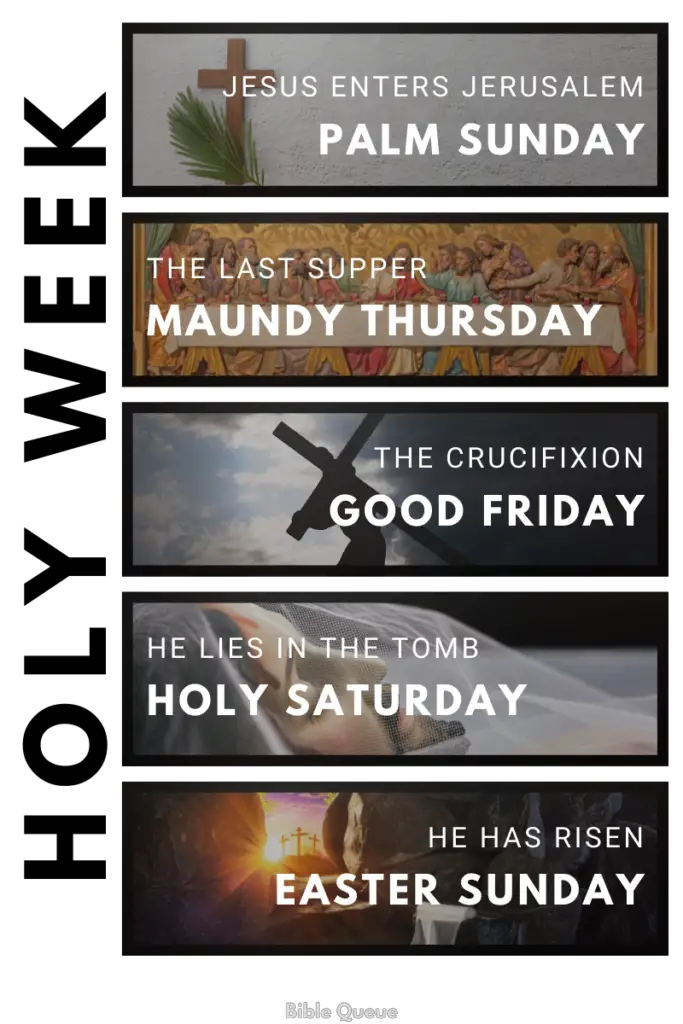Holy Saturday commemorates Christ’s death on the cross and the time His body spent in the tomb. This was a day of great sorrow for His disciples, but also a day of hope, knowing that He would rise again.
Today, we can reflect on His sacrifice and what it means for us. We can also take time to pray for those who are suffering, that they may find comfort in Christ’s love. Holy Saturday is a day of hope and new beginnings and as we prepare to celebrate Easter Sunday, let us remember the great love of our Savior, Jesus Christ.
Holy Saturday is the seventh day of Holy Week and the day before the resurrection.
Holy Saturday is also known as:
- Great and Holy Saturday
- Easter Eve
- Joyous Saturday
- Hallelujah Saturday
- Black Saturday
Holy Saturday in the Bible
On His final day (Good Friday), Jesus Christ is sentenced to death on the cross by Pilate, He is escorted by Roman guards to Golgatha and then Crucified. He dies on the cross and His body is taken down and placed in a tomb.
Joseph asked Pilate that he allow him possession of Christ’s body, where He is then placed in a new tomb. Out of suspicion that Jesus’ supporters may remove His body and appear to fulfill His claims, the chief priests and Pharisees visited Pontius Pilate to request the tomb be made secure.
57 When it was evening, there came a rich man from Arimathea, named Joseph, who also was a disciple of Jesus. 58 He went to Pilate and asked for the body of Jesus. Then Pilate ordered it to be given to him. 59 And Joseph took the body and wrapped it in a clean linen shroud 60 and laid it in his own new tomb, which he had cut in the rock. And he rolled a great stone to the entrance of the tomb and went away. 61 Mary Magdalene and the other Mary were there, sitting opposite the tomb.
62 The next day, that is, after the day of Preparation, the chief priests and the Pharisees gathered before Pilate 63 and said, “Sir, we remember how that impostor said, while he was still alive, ‘After three days I will rise.’ 64 Therefore order the tomb to be made secure until the third day, lest his disciples go and steal him away and tell the people, ‘He has risen from the dead,’ and the last fraud will be worse than the first.” 65 Pilate said to them, “You have a guard of soldiers. Go, make it as secure as you can.” 66 So they went and made the tomb secure by sealing the stone and setting a guard.
These are foundational beliefs of the Christian faith and shortly after would see an establishment of the early church by Christ and his soon-to-be twelve apostles. We celebrate Holy Saturday amongst these tragic and rejoiceful events and find it to be an instrumental day of Holy Week.
Foreshadowing
In the Bible, Jesus’ death and resurrection are foreshadowed in the Old Testament. Interpretations include when the prophet Jonah finds himself in a situation symbolic of His death and return.
Jonah was swallowed by a large fish and then spent three days and nights in its belly before God has him spit up on the shore. This is a metaphorical death, burial, and resurrection.
17 And the Lord appointed a great fish to swallow up Jonah. And Jonah was in the belly of the fish three days and three nights.
The Controversy of The Harrowing of Hell, Jesus’ Triumphant Descent into Hell
The Roman Catholic Church, among others, believes (or believed) that Christ’s time in the tomb on Holy Saturday was spent on a spiritual journey down into hell.
This statement of belief, called the Apostles Creed is widely contested by the denominations that do not take part as being false. There is text within the Bible that may be interpreted as such, but the main statements of the journey are not within the Bible. Your belief in this story may largely depend on your denomination (or non-denomination) and your approach to texts outside of the Bible itself. Even within the context of the stories themselves, there are arguments about the translation and whether or not Christ went into Hell or Hades, which are not the same. Some modern translations have even removed the Harrowing of Hell from their doctrine altogether.
This journey saw the Lord descend into Hell before his return from the dead in order to visit the realm of the dead and save those that came before him. Jesus defeats Satan and allows the gates to be opened, freeing believers that may not have had the opportunity to be saved otherwise.

How is Holy Saturday Celebrated
Holy Saturday is significant because it marks the beginning of Christ’s victory over death. Holy Saturday is typically celebrated by attending church services and reflecting on the meaning of Jesus’ death and resurrection. Many Christians observe Holy Saturday through fasting and prayer, particularly because of its association with Lent.
On the night of Holy Saturday, believers may celebrate the Easter Vigil. Where a Paschal candle is lit and represents Jesus’ return from the dead and bringing His light into our world. This candle is also a symbol of hope and the light of Christ.
Blessed Sabbath
Eastern Orthodox churches celebrate the first Holy Saturday as a day called the Blessed Sabbath. It is often celebrated mid-afternoon before Saturday night with hymns, script reading, and essentially a re-enactment of Holy Saturday and the week as a whole.
Easter Vigil
The Easter Vigil, or Paschal Vigil, is a Christian liturgy held in the hours between sunset on Holy Saturday and sunrise on Easter Sunday. It is the most important liturgical event of the year for many Christians.
The Easter Vigil celebrates the resurrection of the Lord and typically includes The Service of Light, The Service of Lessons, the Baptism of new and old members of the church, where the older members may be bringing themselves closer to Christ through reassurance and reaffirmation of their beliefs, and lastly the Liturgy of the Eucharist. Others may have readings from Scripture, prayers, and hymns.
How Does Holy Saturday Relate to Easter Sunday
Holy Saturday lies between Good Friday and Easter Sunday as a part of Holy Week, which culminates the Easter season on Easter Sunday and tells the story of Jesus’ grand entrance into Jerusalem, his subsequent betrayal, death on the cross and return from the dead three days later.
Holy Week
- Palm Sunday, commemorates Jesus’ triumphal entry into Jerusalem.
- Maundy Thursday remembers the Passover feast known as the Last Supper and Jesus’ institution of the Eucharist (also known as the Holy Communion, or the Lord’s Supper).
- Good Friday is a day of mourning and reflection on Jesus’ crucifixion. Good Friday stands as the previous day to Holy Saturday and is the day of Jesus’ death.
- Holy Saturday is a day of waiting and anticipation, as Christians reflect on Jesus’ death and prepare for His return.
- Easter Sunday is the joyful celebration of Jesus’ Resurrection from the dead on the third day. This event is the foundation of The New Testament and the Christian faith, and we rejoice and give thanks to God for His great love and mercy.

Symbols of Holy Saturday
Paschal Candle
The Paschal candle is lit on Holy Saturday and represents Jesus’ light and return from the dead. It tells us that even in times of crisis and despair, when we find ourselves surrounded by darkness and hopelessness, He is there. When the Paschal Candle is light, other members of the church may have candles of their own to light, and within a dark space, we can see the spread of light from one singular blessing.
Final Thoughts
Jesus died for our sins and it is important to remember His journey completely. Certain pitfalls come with celebrating these events as followers may create their own copy of His story that focuses on the crucifixion and restoration to life alone.
God has granted us this great blessing and as Christ’s followers we must remember to be thankful for what He has done. On Holy Saturday we reflect on His great love, mercy, and sacrifice. Let us not take this day lightly, but let us rejoice in the knowledge that because of Him, death has lost its sting and we can have eternal life.
Note
For the sake of clarity, Catholicism is the largest denomination of Christianity. While we generally try to speak of the Christian experience in our articles from a non-denominational perspective, Holy Week is celebrated by both Catholics and Christians, just predominately by Catholics. A non-denominational church may not celebrate the same way a Catholics might, but the themes and purpose of Holy Week are core beliefs of the Christian faith and important to recognize.





